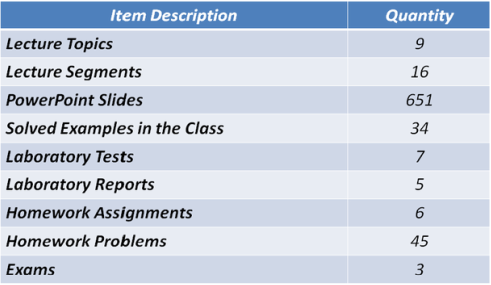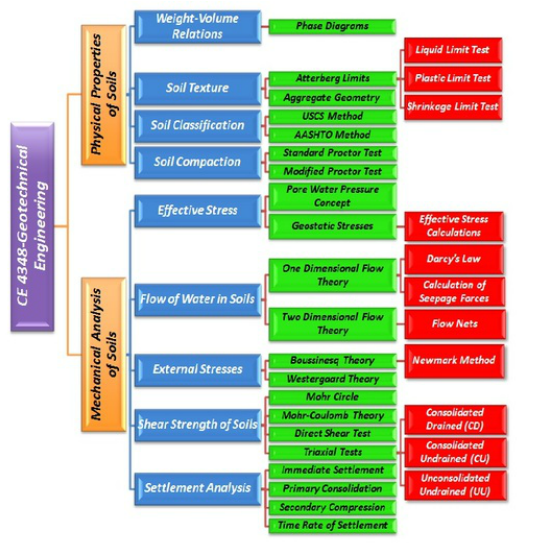Geotechnical Engineering (CE3348)
Course Syllabus
Lecture Topics:
1. Introduction: General definitions and the origin of the soils.
2. Weight-Volume Relations: Phase diagram, void ratio, porosity, water content, degree of saturation, density and unit weight relationships.
3. Soil Texture and Classification: Particle size distribution, shape factors, liquid limit, plastic limit, plasticity index, shrinkage limit, plasticity charts, USCS and AASHTO classification.
4. Compaction: Standard and modified proctor test, factors influencing compaction, moisture-density curves, macro-structure of compacted cohesive clays.
5. Geostatic Stresses: Effective stress and pore water pressure concept, calculation of effective and total stress in single layer and multi-layer soils, effect of change in water table.
6. Hydraulic Conductivity and Seepage: Darcy’s law, hydraulic conductivity, pumping wells, flow nets, and seepage calculation.
7. External Stresses in Soils: Calculation of stresses due to point load, strip load, circular and rectangular area loads, Boussinesq theory, and influence charts.
8. Shear Strength of Soils: Mohr-Coulomb failure criteria, laboratory test for determination of shear strength parameters, triaxial test, and direct shear test.
9. Consolidation: Consolidation theory, OCR, void ratio-effective pressure plots, normally consolidated and over consolidated soils, compression index, swell index, secondary consolidation, and time effect.
2. Weight-Volume Relations: Phase diagram, void ratio, porosity, water content, degree of saturation, density and unit weight relationships.
3. Soil Texture and Classification: Particle size distribution, shape factors, liquid limit, plastic limit, plasticity index, shrinkage limit, plasticity charts, USCS and AASHTO classification.
4. Compaction: Standard and modified proctor test, factors influencing compaction, moisture-density curves, macro-structure of compacted cohesive clays.
5. Geostatic Stresses: Effective stress and pore water pressure concept, calculation of effective and total stress in single layer and multi-layer soils, effect of change in water table.
6. Hydraulic Conductivity and Seepage: Darcy’s law, hydraulic conductivity, pumping wells, flow nets, and seepage calculation.
7. External Stresses in Soils: Calculation of stresses due to point load, strip load, circular and rectangular area loads, Boussinesq theory, and influence charts.
8. Shear Strength of Soils: Mohr-Coulomb failure criteria, laboratory test for determination of shear strength parameters, triaxial test, and direct shear test.
9. Consolidation: Consolidation theory, OCR, void ratio-effective pressure plots, normally consolidated and over consolidated soils, compression index, swell index, secondary consolidation, and time effect.
Laboratory Sessions:

Lab 1. Laboratory Safety Workshop
Lab 2. Sieve Analysis
Lab 3. Atterberg Limits
Lab 4. Standard Proctor Compaction Test
Lab 5. Modified Proctor Compaction Test
Lab 6. Hydrometer Test
Lab 7. Aggregate Imaging System (AIMS)
Lab 8. Direct Shear Test
Lab 9. Triaxial Shear Test
Lab 10. Consolidation Test
Lab 2. Sieve Analysis
Lab 3. Atterberg Limits
Lab 4. Standard Proctor Compaction Test
Lab 5. Modified Proctor Compaction Test
Lab 6. Hydrometer Test
Lab 7. Aggregate Imaging System (AIMS)
Lab 8. Direct Shear Test
Lab 9. Triaxial Shear Test
Lab 10. Consolidation Test

